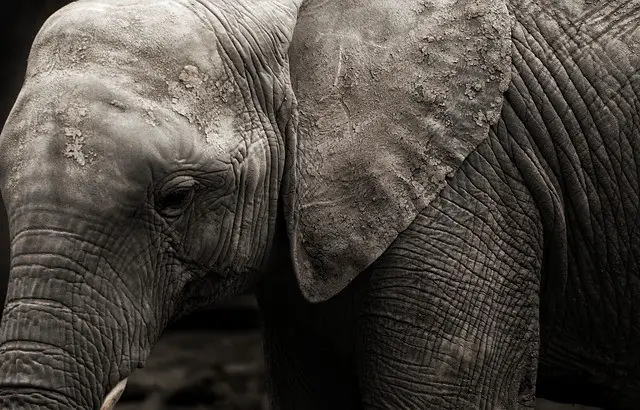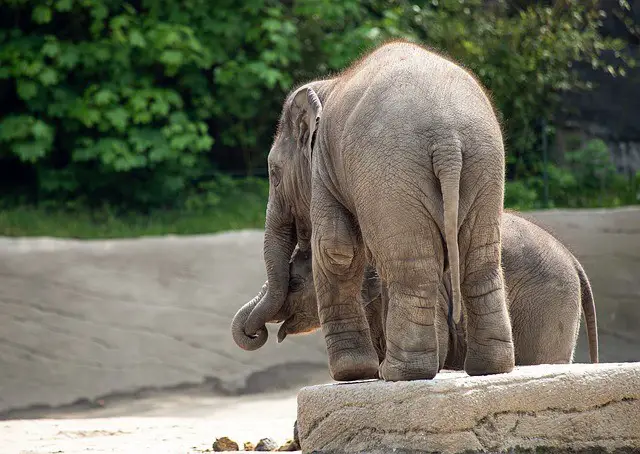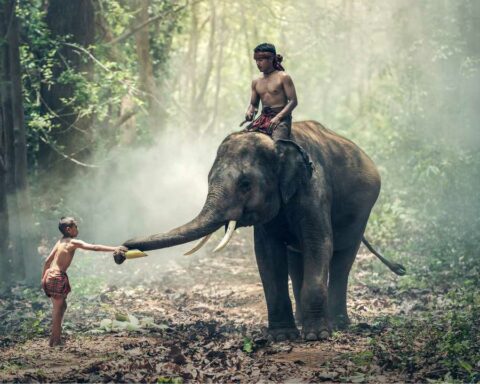Elephants are amazing, well known among kids for their unique appearance and huge size. Among all the animals that live on land, Elephant is the largest. In past, elephants have been used as beasts of burden and in wars. Even today, elephants are still used as beasts of burden in some countries. Here at Kidz Feed, we have gathered a complete set of Elephant Facts For Kids that will teach you all the Elephant Information For Kids that you need to know. You are going to learn all about elephants including their scientific name, classification, species, evolution, characteristics, speed, strength, appearance, color, size, weight, bones, teeth, habitat, diet, lifespan, life cycle, reproduction, elephant baby facts, predators, adaptations, endangerment, population and many other interesting facts about Elephants.
Elephant Facts For Kids
1. What Is An Elephant
- Elephants are mammals of the Elephantidae family.
- They are herbivorous, which means that they only eat plants.
- They are the largest land animal on earth.
- The word elephant is derived from the Greek word Elephas.
- They are divided into three different types which are mentioned below:
- African Bush Elephant
- African Forest Elephant
- Asian Elephant

2. Scientific Name Of Elephant
- The scientific name of the elephant is “Loxodonta”.
3. Elephant Classification – Elephant Taxonomy
- The taxonomy of elephants is given below:
| Kingdom | Animalia |
| Phylum | Chordata |
| Subphylum | Vertebrata |
| Class | Mammalia |
| Order | Proboscidea |
| Suborders | Elephantoidea |
| Families | Elephantidae |
| Species | Total:350 Extinct: 347 Existing: 3 |
4. What Do Elephants Look Like – Elephant Appearance
- Elephants have 4 legs and a tail.
- They have giant ears.
- They have a large trunk.
- Elephants have 26 teeth and 2 Tusks. Tusks are long pointed teeth that grow out of an elephant’s mouth.
5. What Color Are Elephants
- Elephants usually have greyish or mud-colored skin tones.
6. What Is The Size Of An Elephant – Elephant Size
- The average size of an elephant is 8 to 10 feet.
- An African Bush Elephant can attain a maximum size of 13 feet.
- An African Forest Elephant can grow up to the maximum size of 7 feet and 10 inches.
- An Asian Elephant can have a maximum size of 12 feet.
- It means that an African Bush Elephant is known to be the largest elephant species.
How Tall Is An Elephant – Elephant Height
- An elephant’s height is around 11 to 13 feet.

7. How Much Does An Elephant Weigh – Elephant Weight
- The average weight of each specie is:
- African Bush Elephant is 6000 kg.
- Asian Elephant is 5400 kg.
- African Forest Elephant is 2700 kg.
8. Elephant Evolution
- Elephants evolved around 50 million years ago.
- The oldest species of elephants named Moeritherium was small in size and had no trunk.
- Earlier, elephants used to have two sets of tusks. One in the upper jaw and one in the lower jaw. However, today we cannot find any elephant having two sets of tusks.
- Their tail also used to be very small but now their tail is of reasonable length.
- Slowly and gradually the older species of elephants developed the characteristics of modern-day elephants such as a long trunk, a long tail, ivory tusks, etc.
9. Elephant Species – Different Types Of Elephants
- There used to be 350 species of elephants which has just been reduced to 3 now.
- The existing species are:
- African Bush Elephant
- Asian Elephant
- African Forest Elephant
- Some of the extinct species of elephants are:
- Mastodon
- Mammoth
- Deinotherium
10. Elephant Characteristics
- Elephants are known to be very intelligent animals.
- They have wrinkled skin.
- They flap their ears to keep their bodies cool.
- They have very strong tusks which they use for digging.
- They also use their trunks for filling it with water and sprinkling it on their bodies.
Elephant Teeth
- Elephants have 26 teeth.
- Both the African Elephants and the Asian Elephants have two tusks.
- These tusks are strong enough to dig the ground.
- Moreover, they are also used for making jewelry.
Elephants Ears Facts
- Elephants have very big ears.
- They fang them to keep their bodies cold.
- Their big ears also help them in listening to distant voices.

Elephant Eyes Facts
- Elephants have small eyes as compared with their size and long eyelashes.
- However, their vision is not so good.

Elephant Trunk Facts
- Elephants have large trunks with around 150,000 muscles.
- This much muscles keep their trunks flexible and make them strong enough to lift trees.
- They also use their trunks for drinking water and bathing themselves.
Elephant Legs
- Elephants have 4 legs.
- All of their knees face towards the forward direction.
- They can also bend their knees for changing their posture.
Elephant Tail Facts
- Elephants have small and thin tails.
- They are slightly hairy at the tip.
- They move their tails to scare away flies and insects.

11. How Fast Can An Elephant Run – Elephant Speed
- Both the African Bush Elephants and African Forest Elephants can attain a maximum speed of 25 mph (miles per hour) which is equivalent to 40 km/h.
- However, the Asian Elephants are a bit slower and they can attain a maximum speed of 15mph which is equal to 25 km/h.
Read more here: How fast can an Elephant run
12. How Strong Is An Elephant – Elephant Strength
- An elephant’s strength lies in its weight.
- An elephant can weigh as much as 6350 kgs which is equal to the weight of around 130 adult humans.
- An elephant’s trunk alone is capable of lifting 350 kgs of weight.
- The strength of an elephant’s trunk can be realized from the fact that it contains 150,000 muscles.
- Moreover, this trunk is even powerful enough to push down trees.
13. How Strong Is An Elephant Trunk
- An elephant’s trunk (large nose) is composed of around 150,000 muscles.
- Elephants use their trunks for many purposes including smelling, breathing, and filling it up with water for pouring in their mouths for drinking.
- Moreover, their trunks can lift to 350 kgs of weight.
14. How Many Bones Does An Elephant Have – Elephant Bones
- Elephants have 351 bones.
15. How Many Teeth Do Elephants Have
- Elephants have 26 teeth.
16. Where Do Elephants Live – Elephant Habitat
- Elephants can survive in a vast range of habitats such as:
- deserts
- forests
- grasslands
- woodlands.
- The African Bush Elephants are mainly found in
- savanna grasslands
- desert areas
- forests within Central and Southern Africa.
- The African Forest Elephants tend to live mostly in dense rainforests of West and Central Africa.
- However, Asian Elephants mostly prefer to live close to water. But they are also found in the grasslands and forests of India and Southeast Asia.
17. Rainforest Elephant
- The term rainforest elephant refers to the African Forest Elephants.
- They are commonly found in the rainforests of West and Central Africa.
18. Where Are Elephants Found
- The African Bush Elephants are found in the forests, woodlands, wetlands, and savanna grasslands of Central and Southern Africa in countries including:
- Kenya
- Uganda
- Zimbabwe
- Tanzania
- Zambia
- Angola.
- The African Forest Elephants are found in the dense forests of Central and West Africa in countries including:
- Gabon
- Congo
- Liberia
- Ghana
- The Asian Elephants are found in different parts of :
- India
- and Southeast Asia

19. What Do Elephants Eat – Elephant Diet
- Elephants are herbivorous so they feed on plants.
- They spend around 80% of the day feeding themselves.
- Elephants usually eat:
- Grass
- Flowers
- Fruits
- Shrubs
- Chewable woody parts of plants
- Leaves
- Bamboos
- Vegetables
- Sometimes, elephants also use their tusks to dig the ground to find salts and minerals to take as food.
20. How Much Does An Elephant Eat A Day
- They take around 150 to 200 kgs of food daily and drink almost 200 liters of water.
21. Where Do Elephants Sleep
- Elephants can sleep at any place wherever they are living.
- Some of them sleep while lying down while others prefer to sleep while standing.
22. How Long Do Elephants Live – Elephant Lifespan – Elephant Age
- The average age of each of the species is:
- African Bush Elephant is 60 to 70 years.
- Asian Elephant is 48 to 50 years.
- African Forest Elephant is 60 to 70 years.
How Long Do Elephants Live In The Wild – Elephants In Wild
- In the wild, elephants can live up to 70 years but this happens very rarely.
- However, African Elephants (both Bush and Forest) can generally survive for 56 years in the wild, whereas Asian Elephants can survive for up to 42 years.
How Long Do Elephants Live In Captivity – Elephants In Captivity
- The lifespan of an elephant generally shortens in captivity.
- In captivity, the average lifespan of an African Elephant reduces to an average of 17 years whereas that of Asian Elephants is 19 years.
23. Elephant Life Cycle
- All elephant species undergo three stages of the life cycle which are discussed below:
-
The Baby Stage:
-
- This stage starts right from the birth of an elephant until he attains the age of 5 to 10 years.
- During the initial years after an elephant’s birth, he stays close to his mother and learns the basics of living an independent life.
- Between the age of 5 to 10 years, a baby elephant generally stops relying on its mother’s feed and starts eating solid food.
- This is exactly the time when the baby stage ends.
-
The Adolescent Stage:
-
- This stage starts as soon as an elephant abandons taking his mother’s milk and lasts until an elephant is around 17 years old.
- During the age of 8 to 13 years, an elephant attains sexual maturity but generally, elephants do not mate in the adolescent stage.
- At this point, all they do is to leave their herd and start forming groups of peers which are known as Bachelor Pods.
-
The Adult Stage:
-
- This stage starts when the elephant attains the age of 18 years and ends with an elephant’s death.
- When an elephant is 20 years old, it is all set to mate with another elephant.
- They can keep doing that until they attain the age of 50 years after which they stop giving birth to babies.
- As soon as they give birth to a baby, the same life cycle continues for them.
24. How Do Elephants Reproduce – Elephant Reproduction – Elephant Breeding
- Elephants undergo sexual reproduction.
- When a female elephant is ready to mate, she produces a certain sound that is loud enough to be heard by other elephants.
- Then whichever male elephants hear this sound and want to mate, start walking towards that female elephant.
- Once they reach there, they fight after which the winner of the fight is allowed to mate with the female elephant.
- The female elephants generally mate once they attain the age of 14 years, whereas the male elephants do not mate until they are 30 years old.
- The time between the consecutive breedings of elephants is generally 5 to 6 years.
- Both the breeding and birth of elephants take place in the wet season.
How Long Are Elephants Pregnant – Elephant Pregnancy
- An elephant’s pregnancy period lasts for 22 months.
How Often Do Elephants Reproduce
- Once an elephant gives birth to a baby, it can only reproduce after 5 to 6 years of this birth.
25. Baby Elephant Facts
- Baby elephants weigh around 115kgs. However, at the time of birth, their weight is somewhere between 90 to 120 kgs.
- They are around 3 feet tall.
- Most of the baby elephants are born at night.
- The skin of baby elephants is initially covered with hair. These hair keep their bodies cool.
- Baby elephants stay very close to their mothers until they attain adolescent age.
- They drink around 3 gallons (which is almost equivalent to 11.3 liters) of milk each day.
- They sometimes suck their trunks when they are hungry.
- They recognize their mothers by their smell, touch, or voice when they are unable to see them.
What Is A Baby Elephant Called
- A baby elephant is called a calf.
26. How Many Babies Do Elephants Have
- In a whole lifetime, a female elephant can give birth to at most 12 calves.
28. Elephant Ecosystem
- Elephants leave some very important and have fascinating impacts on the ecosystem.
- Whenever they run out of water supplies, they use their tusks to dig into the soil and extract water. Doing this not only creates a water resource for themselves but also for many other animals.
- Elephants are also very good seed dispersers i.e. they eat fruits and carry their seeds to other places and then plant them. This allows more plants to grow.
- Moreover, they also clear out the paths by eating and pulling down trees and shrubs hence making it easier for other animals to move from one place to another.
29. What Eats An Elephant – What Are Elephants Predators
- Elephants normally have a lesser number of predators as compared to other animals because of their huge size.
- However, the following animals can eat young or injured elephants:
- Lions
- Wild Dogs
- Hyenas
- Crocodiles
30. Are Elephants Dangerous To Humans
- Elephants are generally peaceful by nature.
- However, if they are sick or hurt, they can prove to be dangerous to humans.
- An elephant’s attack can be life-threatening because of its huge size and heavyweight.
31. Elephant Adaptations
Elephant Physical Adaptations:
- Elephants have a huge size and they are the biggest land animal. Their huge size keeps them safe from most predators.
- They have wrinkled grey skin. These wrinkles help their skin to retain moisture hence making them look fresh.
- They have 4 legs and a tail.
- Their eyelashes are very long which makes their small eyes look very attractive.
- They have a long trunk. With the help of this trunk, they can lift heavy objects. Moreover, it is generally used for breathing, smelling, eating, and drinking.
- They have ivory tusks. These tusks are so strong that they can be used to dig the ground.
- They have very big ears. Elephants fang them for keeping their bodies cool.
Elephant Behavioral Adaptations
- Elephants are very caring and emotional by nature.
- They even communicate with each other by making different sounds.
- They mourn over their dead fellows.
- They sleep only for 2 to 4 hours per day.
- Elephants are great swimmers.
- The male elephants leave their herd as soon as they stop taking mother feed.
32. Are Elephants Endangered
- According to the International Union for Conservation of Nature (IUCN), the African Elephants are listed as Vulnerable and the Asian Elephants are categorized as Endangered.
33. Why Are Elephants Endangered
- Elephants are endangered due to illegal poaching and habitat destruction.
- Elephants are mostly hunted for their precious ivory tusks.
- These tusks are then sold for a huge amount of money. This is exactly why hunters are tempted towards hunting for an elephant.
- Also, elephants consume a lot of food and many people think that they eat our portion of food too. That is why they do not consider it wrong to indulge themselves in the illegal killing of elephants.
- Many elephants starve to death because of lack of food availability.
- Moreover, because of the expansion in human settlements, the habitats of elephants have been badly disturbed.
- Another fact that must be taken into account is that an elephant has an unreasonably long gestation period. It means that it takes almost 2 complete years to give birth to an elephant. Therefore, it is very difficult to increase the population of elephants and save them from extinction.
34. Are Elephants Going Extinct
- Elephants are on the verge of going extinct because their number has reduced to 50% over the last decade.
35. How Many Elephants Are Left In The World – Elephant Population
- The population of African Elephants is around 415,000.
- The population of Asian Elephants is less than 90,000.
36. Interesting Facts About Elephants – Fun Facts About Elephants For Kids
- The word Elephant is derived from the Greek word Elephas which means Ivory.
- Elephants are the biggest land animals.
- They have the longest gestation period (22 months) as compared with any other animals in the world.
- They have very big ears which they flap for cooling their bodies.
- They use their trunks to bathe themselves.
- Elephants are considered very intelligent.
- The tusks of an elephant keep growing for the whole of his lifetime.
- They spend around 18 hours of the day feeding themselves.
- They are also responsible for transporting seeds from one place to another.
- Elephants can dig the ground with their strong tusks.
- They can even pull down trees with the help of their trunks.
- Elephants protect themselves from sunburns simply by covering their bodies with sand and mud right after taking a bath.
- They can swim.
- Elephants are very caring by nature. That is exactly why they prefer to live in groups called herds.
- They interlock their trunks for greeting each other.
- Elephants love to eat bananas.
- They cry when they are upset or when they lose a dear one.
38. FAQs About Elephants
How Smart Are Elephants
- Elephants are exceptionally smart creatures.
- They have a very sharp memory.
- They can understand the body language of humans as well as of other animals.
- Elephants can even recognize themselves in the mirror.
- When the baby elephants cannot see, they recognize their mothers with their smell, touch, or voice.
- When they do not find anything to eat, they simply dig the ground with their trunks and start taking salts and minerals.
- Elephants can even mimic human voices.
- They can also fill up their thirst by digging for water supplies for themselves.
What Is An Elephant’s Favorite Food
- Elephants love to eat grass, tree bark, and bananas.
What Fruits Do Elephants Eat
- Elephants eat a large number of fruits including
- bananas
- apples
- pears
- pineapples
- melons
How Many Babies Do Elephants Have At One Time
- Elephants usually give birth to a single baby at a time but in some cases, twins are also possible.
Can Elephants Cry
- Yes, elephants do cry whenever they are upset or on the death of a fellow elephant.
Do Elephants Lay Eggs
- No, elephants do not lay eggs.
Can Elephants Swim
- Yes, elephants can swim. They just love water.
Are Wild Elephants Dangerous
- Wild elephants can be dangerous for you if you try to harm them. Otherwise, elephants are very friendly and gentle by nature.









